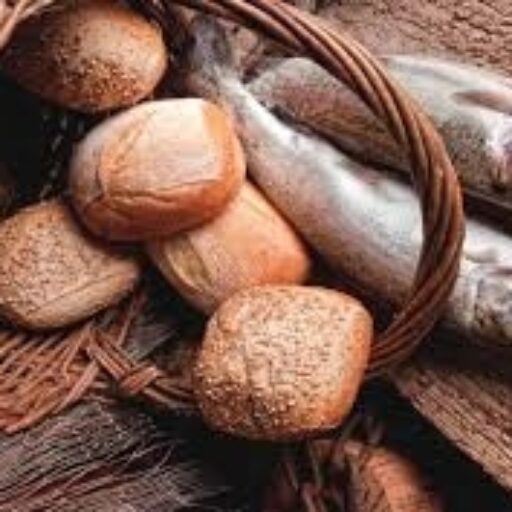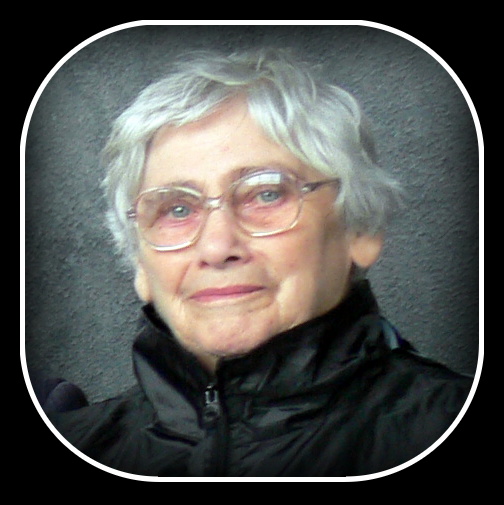
by Vincent | Feb 23, 2015 | General Interest, Reflections, Parish and Diocese, Religion
On Sunday, February 22nd 2015, I celebrated a Funeral Mass in Monasteraden. The Mass was for Mary Corcoran who had died a few days earlier. I’ve known Mary all my life and came to know her very well during the years I worked in Ballaghaderreen Parish where I had special care for the Monasteraden area of the parish. Mary played the organ in the church and had an involvement in the choir for something in the region of eighty years – from her childhood days. Her commitment was remarkable. I was asked to be Principal Celebrant at her Funeral Mass and was honoured to accept that invitation and thankful to the priests of the parish and others who joined with me for the Mass – not least Fr James Sharkey, SPS, a cousin and lifelong friend of Mary. I am going to share here the words used at Sunday’s Mass. I know Mary read this blog and I hope she approves of the inclusion of these words in her memory. In so doing, I offer my renewed sympathy to her son Michéal, daughters Noreen and Marie, to her sons-in-law, daughters-in-law, her grandchildren and Mary’s neighbours and friends. I remember too, her son Philip, R.I.P. who died in June 2012.
Mary Corcoran died! I think that’s what she’d expect me to say today. Not so sure she’d talk about having “passed” or “slipped away” – no she’d say “died”, “dead” …. I remember writing in August 2009 “my mother died” – they were three words with just twelve letters but the brevity of their content didn’t reflect the enormity of their significance. No less so for Mary’s children and their families here today. This is a life-changing moment. I don’t think she’d want it sugar coated or downplayed. We are here because Mary Corcoran died.
And here we are! We gather to say our prayers – with face to the Altar and back to the gallery. Both places of huge significance for Mary. It was at this Altar she was baptized, received Eucharist for the first time, stood beside Billy as vows were exchanged, brought her four for baptism, bade farewell to Philip – here she found strength for the journey, the faith to carry on and the gift to believe. It’s certain this is where she wants to be right now – placed at the foot of this Altar so that prayers can be offered, memories evoked and thanks can be said.
The gallery too, in full voice and sound today re-echoes her countless notes played and sung in praise of his name. The twelve letters I wrote in August 2009 and the eight notes of the octave, have in common the ability to take us elsewhere. A church without music is an impoverished church. A liturgy without music, though remaining liturgy, lacks a central element. Mary ensured that was not to be the story in Monasteraden. Faithfully she climbed those steps, turned on the music, shared the notes and encouraged song. She walked up and, I believe backed down but between the walking and the backing she made music happen and this church has been the better of that. It’s great to hear that sound here again today. Long, long may it be heard when “two or three” gather in His name!
I read somewhere during the week “Repent, so that the preacher doesn’t have to tell lies at your funeral”!! I’m not here to tell lies. I believe Mary Corcoran was a good woman. Direct! For sure!! More than once she let me know when I got it wrong but many times more than once she let me know when I got it right! She had a directness that was rooted in love of place and was always well intentioned. She did not like to see anything diminish the place and “people make places” so, in many ways, she didn’t like anything that diminished people – her people (family), neighbours and the Church. There’s a line in Scripture that speaks of “Zeal for your house consumes me” and I think it’s a line that ran deep in the veins of Mary. We need people like that and we’re impoverished without them.
So here we are, in this Gospel moment – a meal has just been shared and the penny has dropped. These two men have been walking the road and sharing a meal with Jesus. It’s when he’s gone the fullness of that reality dawns. We sometimes refer to this Gospel passage as the “Road to Emmaus”. Lately I’ve been thinking of it more in terms of the Road from Emmaus. The road to it is one thing but the road from it another. Where do we go when the truth has dawned? What do we do with and about that truth? The men in the story re-traced their journey and told their story to those to whom they felt it would make difference so that they could tell it to others.
I think that’s where we are now! Mary lived for almost ninety years. She travelled but most of her travelling was local. Walking, cycling or driving – her destination was quite often where we now gather – St Aidan’s Church. She rejoiced with people on happy days and shared their grief on days of sadness. She brought her family here and taught them how to pray. She heard hymns she liked and took them to the gallery (the odd song too!! “Isle of Inisfree!”). She lit candles in the quietness of this Sacred Space and, in their flicker, remembered the dead and the living (I’m humbled to say, me among them). She remained faithful when many, for a variety of reasons, walked away from Faith and practice. This is where we are. Mary’s road to Emmaus led her to encounter and recognise the Lord, even in the darkness of her son’s illness and death and to find strength for the journey.
Where to for her son, daughters and their families today? Where to for the choir? Where to for neighbours and friends? Where to for all of us from this moment? We can’t be sure where the road will take us but we can be sure we’ll not walk it alone. Let all that was good in Mary be recalled? Let the Faith loved by Mary be lived and let the song sung by Mary lead us to the chorus:
“With him, I am risen” …. May she rest in peace. Amen.

Mary Corcoran, R.I.P.
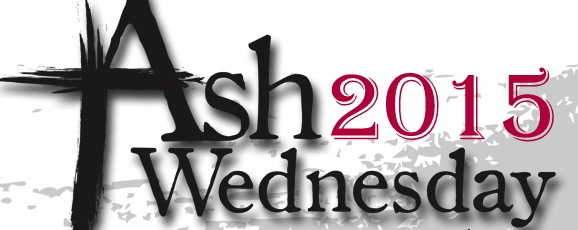
by Vincent | Feb 18, 2015 | General Interest, Reflections, Parish and Diocese, Religion

Ashes blessed, forehead
with blessed ash dressed
marked for the day and
called to pray
to fast to give
in faith to live
and trust his plan
for woman, for man
so here we start
renewed soul, mind and heart
our foreheads declare
“I was there”
when he, when she
when you, when me
saw him crucified
and tried to hide
lest we be named
and with him shamed
and marked we bow
not then but now
to say crucifixion no more
but him adore
and ask his strength
to live this Lent
day by day
to fast, to pray
to give, to live
and we as one
journey begun
remember the loss
of the twenty-one of the cross
who in recent days
sought him to praise
as Calvary came
because they praised his name
On this blessed day
through ash and clay
we pray for PEACE
let senseless bloodshed cease.
“Turn away from sin …. be faithful to the Gospel”

by Vincent | Feb 6, 2015 | General Interest, Reflections, Religion, Photography

This is the Sanctuary in St Joseph’s Church, Urlaur (Parish of Kilmovee). St Joseph’s is the newest church in Achonry Diocese – blessed and opened, by Bishop James Fergus, in 1969. There’s a great story to go with this church so might share a bit of it here …
In the early 1960’s there was no church in Urlaur. There had been an Abbey that ceased being used in the late 1800’s. People from Urlaur went to Mass in nearby Kilmovee, Glann, Kilkelly and some (I’m told) even went to the neighbouring parish of Tooreen!! There was a priest in the parish at the time who didn’t altogether like the idea of people leaving the parish for Mass so he started to celebrate Mass in the local primary school. He also, in fairness, was deeply aware of the role of the Abbey in Urlaur and felt the Faith of the people would be enriched through the presence of a church in the locality. This idea caught on and, from it, people looked at the possibility of building a new church for the Urlaur area of our parish. This was a massive undertaking since the population was relatively small but the project commenced.
Locals got behind it with full enthusiasm and many fundraising ideas were put to work. These included door to door collections locally and in neigbouring towns. People worked very hard to make the dream of a church come through.
Move the story about three thousand miles. Many years earlier a young fifteen year old girl left Urlaur and went to the United States. Later she entered an order of enclosed Sisters in New Jersey. She received word from home that a new church was going to be built. She was happy about this and decided to share the news with, wait for it the “New York Times”. Her letter wound its way to the desk of Nat Goldstein. As the name suggests he was not a native of East Mayo!! He was a Jew but was nonetheless impressed by the letter received and asked two journalists to go and visit the sister.
They reported back to him the outcome of their visit and said it was quite an experience. They spoke through a little meshed opening to Sister Mary of The Blessed Trinity (formerly Margaret Cafferkey from Aughadeffin) who shared with them her lifelong dream that there be a church in which her neighbours and family could pray. Towards the end of the interview, Sister Mary told the reporters she had been quite nervous about meeting them since she had been fifty-five years in the convent and they were her first visitors in fifty years!!
Goldstein impressed by the report and still conscious of Margaret’s letter and, in particular, one line which said her people wanted to build a “place of worship” took up the cause. Shortly afterwards, at a function marking his forty years service to the New York Times, he was prsented with $1000 and sent half of it to Sr Mary for the work on St Joseph’s.
He didn’t stop at that. He wrote to friends and presumably used the New York Times asking people to send him $5.00 to “help make and Irish Fairytale come true”! As a result more than $10,000.00 was collected (this was about £6000 of the £16,000.00 it took to build the church). All from one letter from a sister in an enclosed order. (Ironically some feel that enclosed orders don’t influence life beyond their walls ……. )
Goldstein later said that he liked the line about the “place of worship” and felt the world would be a better place if it had more “places of worship”. He said her letter was “full of faith and deserved more than a little notice”. He together with his wife attended the opening of Urlaur Church on Ascension Thursday, May 15th 1969. So also, the Commissioner of the New York Police Department (Howard Leary), his wife and two other visitors from New York – Irving Taubkin of the New York Times and his wife). The “place of worship” in a small part of East Mayo captured the imaginations of many.
Today that church is open. Its invitation to worship is as real and intense as it was on that Ascension Day in 1969. Its call is as sure. Chances are there’s a church open near enough to wherever you are right now … a quick visit might be no bad thing ….
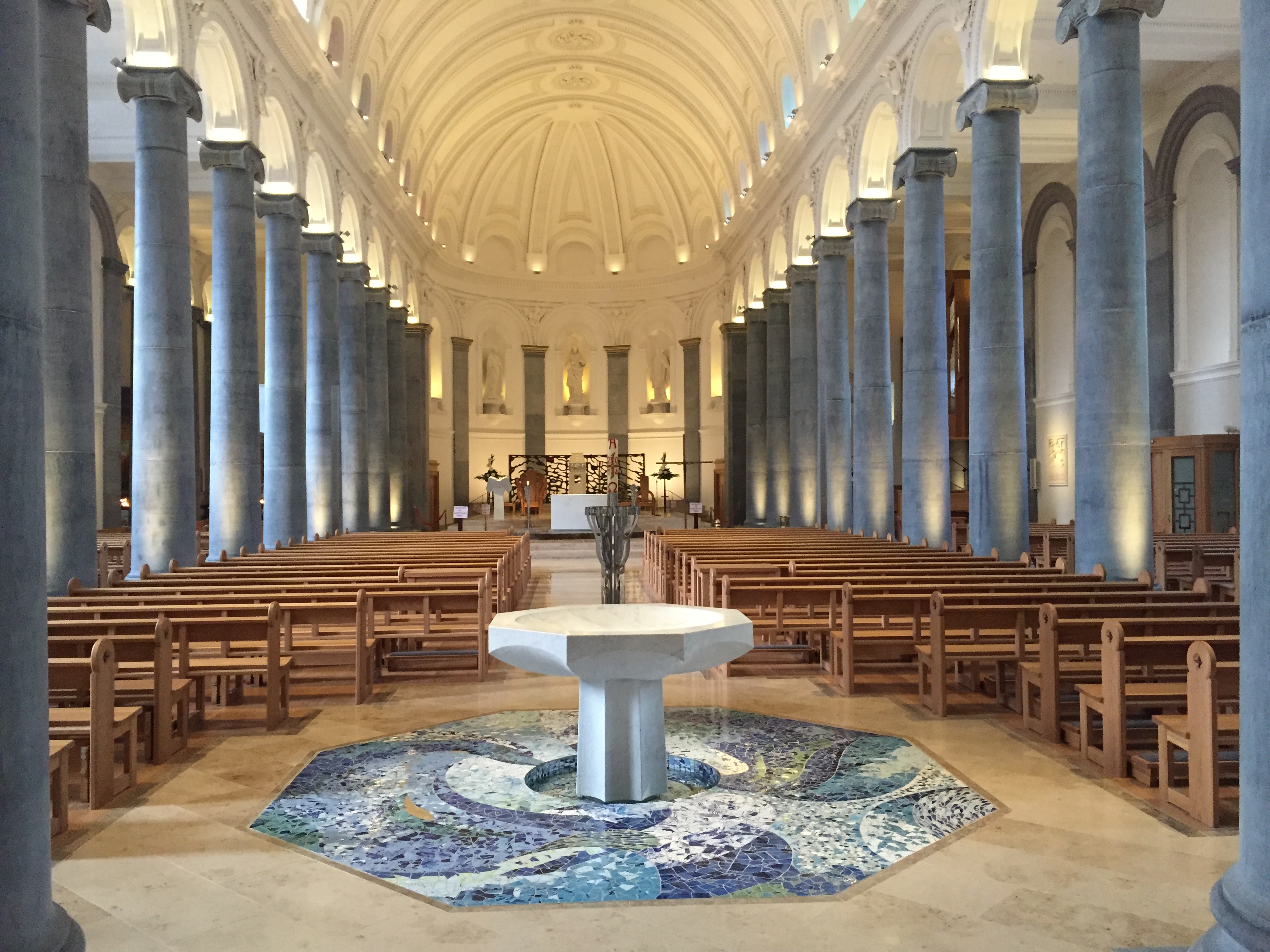
by Vincent | Feb 5, 2015 | General Interest, Reflections, Religion, Photography
Earlier today, I visited St Mel’s Cathedral in Longford. Like many, I had seen images and the fine documentary presented by RTE’s Ciaran Mullooly but the reality of the place outshone all images and imagination! A true credit to all involved. I had the added bonus of meeting Bishop Colm O’Reilly and Bishop Ray Browne as I was heading into the cathedral. Bishop Colm came in with me and shared a few thoughts around the work done. I was happy to be able to congratulate him, since I know the Cathedral and Longford hold a special place in his heart and ministry. I also met Fr Tom Healy, Adm in the Cathedral and congratulated him on a job well done. The right man for the hour.
[wpvideo cY5FyPhU]
[wpvideo aizcqKFH]
I took a few photos to add to the countless images already on line but these are mine! They speak to me of a visit to a very special space and place. I’m glad this work has been done and full credit to all involved.
I was struck by the Stations of The Cross and, in particular, by the places still to be filled by some of the Stations. There’s room for thought there – where am I, where are you to be found in these Stations? The one below, for example, the Ninth Station – Jesus falls for the third time – where are we in that fall? Where are we in our own falls?

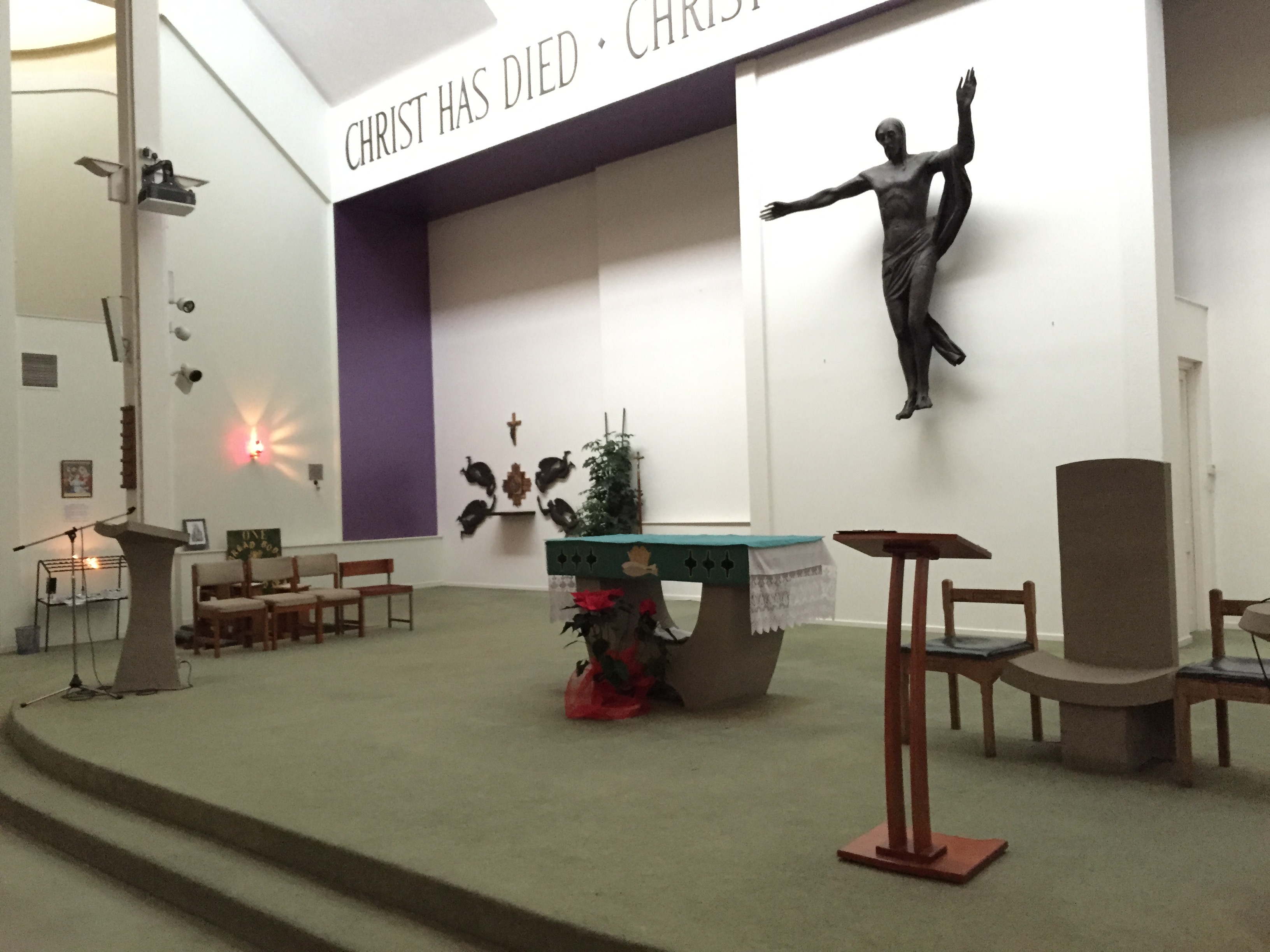
by Vincent | Feb 1, 2015 | General Interest, Reflections, Religion, Photography
Spent a few days around London this week. It’s always a nice chance to meet a few people. I used the train more the past week than I have done in a long time. There’s no doubt it’s a great service. I was struck again by that phrase “mind the gap” that is announced with such frequency and urgency as the train approaches the platform. A reminder to all that there’s need for care as the step is taken from the train to the platform.
That image of “gap” remains with me and I realise again its potential to cause danger in friendships, relationships, family life and faith. If we don’t address the “gap” there’s a real risk that much of what is important in life falls between “the track and the platform” – the journey we’re on and where we stand. The gap, like track and platform, needs to be acknowledged.
During the week, I had the chance to bridge one gap! The year before I was ordained a priest, I spent a few weeks in the summer of 1986 in a parish in North London. It was called St Gabriel’s on the Holloway Road. I returned a few times after I was ordained for a quick visit but the priests I knew there moved to St Mellitus in Tollington Park and later, back home to Ireland, so my link with both these places ceased and “the gap” took its toll!
I visited some friends in Wapping on one of the days and planned on meeting two cousins later in the evening so in between I decided to bridge the gap:)
The Northern Line took me to Archway Tube Station and when I reached the street it all looked so different. I had to ask someone for the Holloway Road which was just around the corner. There used to be an old dance hall on the Holloway Road. It was called “The Gresham” and, I’ve no doubt, many’s a match was made there. It was directly opposite the church but not anymore. It wasn’t in use for many years but seems to have been totally replaced now. I’m not sure what stands where it stood but St Gabriel’s is there and I was happy to find it open and welcoming.
I really can’t say whether it has changed or not but I remember preaching there the first Saturday evening I went as a deacon. It was such an experience to look into this modern church, with the people in a sort of semi-circle before you and have the chance to speak to a congregation. At the time, it was a parish in the care of the Irish Chaplaincy and was a very “Irish parish” in many ways. I met many young people there and it was lovely to think they saw the parish as a place to meet others, share a bit of faith and go on their way. The priests there at the time were good men and worked hard to keep a link with the existing parish and the many Irish people who saw it as part of their landscape for a while.
My mother, God rest her, was coming out of Tubbercurry on the Monday or Tuesday after I went to St Gabriel’s and gave a lift to two young people who were thumbing. They told her they were going to Boyle and when she said she was going to Gurteen, they told her they’d met a priest from Gurteen at Mass the previous Saturday evening. Then they said “he wasn’t a priest he was a deacon”!! Needless to say my “proud” mother left them to Boyle:) A small but connected world.
There was a lady saying a few prayers in the church and as we left I spoke with her. I told her I’d been in St Gabriel’s for a while in the summer of 1986, when I was a deacon. She then asked the reassuring question “are you still a priest?” It’s a sign of the times I suppose when it can’t be assumed a person is still a priest! An understandable sign of course. I told her I am and she said she likes St Gabriel’s though it’s not her parish. We chatted for a little while and then she left. I wandered around for a while and tried to connect with that summer. I’m not sure it was a totally successful connection but I was glad to be there.
I looked at the Parish Bulletin and noticed the parish is now in the care of the Holy Ghost Order. The three priests attached to the parish are African – two of them born the same year as myself and the third a few years younger. Their photos are in the porch and they look like happy and good men. I’ve no doubt the parish is in good hands. The names of people involved in the various ministries told a story of a parish that has changed. I think I spotted one name that would have a loose connection with Ireland. All the others were African or Oriental. That’s not new. It was one of the lovely aspects of St Gabriel’s and a welcome eye-opener to me that there was such a variety of people and cultures there. That said, I thought the shift had changed and a new team of workers had taken to its task. The Irish Chaplaincy team had its opportunity to put a shape on a place and now these three men and their many helpers add another dimension. I wondered how many remembered the Irish priests that were there in the 80’s?
I was very pleased to be there again and many happy memories came back to me. I won’t leave it as long next time but for now, I’ve “minded the gap”.

